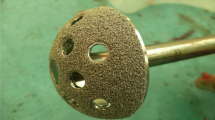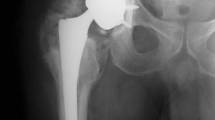Abstract
Background
Aseptic osteolysis has been the single most important factor limiting the longevity of a THA. A great deal of attention has been focused on the development of implants and materials that minimize the development of osteolysis. The monoblock porous tantalum acetabular cup was designed to minimize osteolysis, but whether it does so is unclear.
Questions/purposes
We evaluated the incidence of osteolytic lesions after THA using a monoblock porous tantalum acetabular component.
Methods
We retrospectively reviewed 51 patients who had a THA using a monoblock porous tantalum acetabular cup. At a minimum of 9.6 years postoperatively (average, 10.3 years; SD, 0.2 years; range, 9.6–10.8 years), a helical CT scan of the pelvis using a metal suppression protocol was obtained. This scan was evaluated for the presence of osteolysis.
Results
We found no evidence of osteolysis on CT scan at an average of 10.3 years.
Conclusions
Osteolysis appears not to be a major problem at 10 years with this monoblock porous tantalum acetabular component, but longer term followup will be required to determine whether these findings persist.
Level of Evidence
Level IV, therapeutic study. See Guidelines for Authors for a complete description of levels of evidence.

Similar content being viewed by others
References
Archibeck MJ, Surdam JW, Schultz SC Jr, Junick DW, White RE. Cementless total hip arthroplasty in patients 50 years or younger. J Arthroplasty. 2006;21:476–483.
Bankston AB, Faris PM, Keating EM, Ritter MA. Polyethylene wear in total hip arthroplasty in patient-matched groups: a comparison of stainless steel, cobalt chrome, and titanium-bearing surfaces. J Arthroplasty. 1993;8:315–322.
Bobyn JD, Poggie RA, Krygier JJ, Lewallen DG, Hanssen AD, Lewis RJ, Unger AS, O’Keefe TJ, Christie MJ, Nasser S, Wood JE, Stulberg SD, Tanzer M. Clinical validation of a structural porous tantalum biomaterial for adult reconstruction. J Bone Joint Surg Am. 2004;86(Suppl 2):123–129.
Bobyn JD, Toh KK, Hacking SA, Tanzer M, Krygier JJ. Tissue response to porous tantalum acetabular cups: a canine model. J Arthroplasty. 1999;14:347–354.
Christie MJ. Clinical applications of Trabecular Metal. Am J Orthop (Belle Mead NJ). 2002;31:219–220.
Claus AM, Totterman SM, Sychterz CJ, Tamez-Pena JG, Looney RJ, Engh CA, Sr. Computed tomography to assess pelvic lysis after total hip replacement. Clin Orthop Relat Res. 2004;422:167–174.
Clohisy JC, Calvert G, Tull F, McDonald D, Maloney WJ. Reasons for revision hip surgery: a retrospective review. Clin Orthop Relat Res. 2004;429:188–192.
Della Valle CJ, Mesko NW, Quigley L, Rosenberg AG, Jacobs JJ, Galante JO. Primary total hip arthroplasty with a porous-coated acetabular component: a concise follow-up, at a minimum of twenty years, of previous reports. J Bone Joint Surg Am. 2009;91:1130–1135.
Dobzyniak M, Fehring TK, Odum S. Early failure in total hip arthroplasty. Clin Orthop Relat Res. 2006;447:76–78.
Engh CA Jr, Sychterz CJ, Young AM, Pollock DC, Toomey SD, Engh CA Sr. Interobserver and intraobserver variability in radiographic assessment of osteolysis. J Arthroplasty. 2002;17:752–759.
Gruen TA, Poggie RA, Lewallen DG, Hanssen AD, Lewis RJ, O’Keefe TJ, Stulberg SD, Sutherland CJ. Radiographic evaluation of a monoblock acetabular component: a multicenter study with 2- to 5-year results. J Arthroplasty. 2005;20:369–378.
Harris WH. The problem is osteolysis. Clin Orthop Relat Res. 1995;311:46–53.
Hirakawa K, Jacobs JJ, Urban R, Saito T. Mechanisms of failure of total hip replacements: lessons learned from retrieval studies. Clin Orthop Relat Res. 2004;420:10–17.
Howie DW, Neale SD, Stamenkov R, McGee MA, Taylor DJ, Findlay DM. Progression of acetabular periprosthetic osteolytic lesions measured with computed tomography. J Bone Joint Surg Am. 2007;89:1818–1825.
Kim YH. Long-term results of the cementless porous-coated anatomic total hip prosthesis. J Bone Joint Surg Br. 2005;87:623–627.
Kitamura N, Leung SB, Engh CA Sr. Characteristics of pelvic osteolysis on computed tomography after total hip arthroplasty. Clin Orthop Relat Res. 2005;441:291–297.
Kitamura N, Naudie DD, Leung SB, Hopper RH Jr, Engh CA Sr. Diagnostic features of pelvic osteolysis on computed tomography: the importance of communication pathways. J Bone Joint Surg Am. 2005;87:1542–1550.
Laupacis A, Bourne R, Rorabeck C, Feeny D, Wong C, Tugwell P, Leslie K, Bullas R. The effect of elective total hip replacement on health-related quality of life. J Bone Joint Surg Am. 1993;75:1619–1626.
Leung S, Naudie D, Kitamura N, Walde T, Engh CA. Computed tomography in the assessment of periacetabular osteolysis. J Bone Joint Surg Am. 2005;87:592–597.
Levi AD, Choi WG, Keller PJ, Heiserman JE, Sonntag VK, Dickman CA. The radiographic and imaging characteristics of porous tantalum implants within the human cervical spine. Spine (Phila Pa 1976). 1998;23:1245–1250; discussion 1251.
Macheras G, Kateros K, Kostakos A, Koutsostathis S, Danomaras D, Papagelopoulos PJ. Eight- to ten-year clinical and radiographic outcome of a porous tantalum monoblock acetabular component. J Arthroplasty. 2009;24:705–709.
Macheras GA, Papagelopoulos PJ, Kateros K, Kostakos AT, Baltas D, Karachalios TS. Radiological evaluation of the metal-bone interface of a porous tantalum monoblock acetabular component. J Bone Joint Surg Br. 2006;88:304–309.
Mayman DJ, Anderson JA, Su EP, Sculco TP. Wear data and clinical results for a compression molded monoblock elliptical acetabular component: 5- to 9-year data. J Arthroplasty. 2007;22:130–133.
Meneghini RM, Ford KS, McCollough CH, Hanssen AD, Lewallen DG. Bone remodeling around porous metal cementless acetabular components. J Arthroplasty. 2009;25:741–747.
Mulier M, Rys B, Moke L. Hedrocel trabecular metal monoblock acetabular cups: mid-term results. Acta Orthop Belg. 2006;72:326–331.
Puri L, Lapinski B, Wixson RL, Lynch J, Hendrix R, Stulberg SD. Computed tomographic follow-up evaluation of operative intervention for periacetabular lysis. J Arthroplasty. 2006;21:78–82.
Puri L, Wixson RL, Stern SH, Kohli J, Hendrix RW, Stulberg SD. Use of helical computed tomography for the assessment of acetabular osteolysis after total hip arthroplasty. J Bone Joint Surg Am. 2002;84:609–614.
Robertson DD, Sutherland CJ, Lopes T, Yuan J. Preoperative description of severe acetabular defects caused by failed total hip replacement. J Comput Assist Tomogr. 1998;22:444–449.
Sculco TP. The acetabular component: an elliptical monoblock alternative. Orthopedics. 1998;21:973–974.
Sculco TP. The acetabular component: an elliptical monoblock alternative. J Arthroplasty. 2002;17:118–120.
Stiehl JB. Trabecular metal in hip reconstructive surgery. Orthopedics. 2005;28:662–670.
Stulberg SD, Wixson RL, Adams AD, Hendrix RW, Bernfield JB. Monitoring pelvic osteolysis following total hip replacement surgery: an algorithm for surveillance. J Bone Joint Surg Am. 2002;84(Suppl 2):116–122.
Surdam JW, Archibeck MJ, Schultz SC Jr, Junick DW, White RE Jr. A second-generation cementless total hip arthroplasty mean 9-year results. J Arthroplasty. 2007;22:204–209.
Walde TA, Weiland DE, Leung SB, Kitamura N, Sychterz CJ, Engh CA Jr, Claus AM, Potter HG, Engh CA Sr. Comparison of CT, MRI, and radiographs in assessing pelvic osteolysis: a cadaveric study. Clin Orthop Relat Res. 2005;437:138–144.
Wang JC, Yu WD, Sandhu HS, Tam V, Delamarter RB. A comparison of magnetic resonance and computed tomographic image quality after the implantation of tantalum and titanium spinal instrumentation. Spine (Phila Pa 1976). 1998;23:1684–1688.
Xenakis TA, Macheras GA, Stafilas KS, Kostakos AT, Bargiotas K, Malizos KN. Multicentre use of a porous tantalum monoblock acetabular component. Int Orthop. 2009;33:911–916.
Zardiackas LD, Parsell DE, Dillon LD, Mitchell DW, Nunnery LA, Poggie R. Structure, metallurgy, and mechanical properties of a porous tantalum foam. J Biomed Mater Res. 2001;58:180–187.
Zimlich RH, Fehring TK. Underestimation of pelvic osteolysis: the value of the iliac oblique radiograph. J Arthroplasty. 2000;15:796–801.
Acknowledgments
We thank Dr. Renee Yap for her assistance in the evaluation of the CT scans for this paper.
Author information
Authors and Affiliations
Corresponding author
Additional information
Each author certifies that he or she has no commercial associations (eg, consultancies, stock ownership, equity interest, patent/licensing arrangements, etc) that might pose a conflict of interest in connection with the submitted article.
Each author certifies that his or her institution approved the human protocol for this investigation, that all investigations were conducted in conformity with ethical principles of research, and that informed consent for participation in the study was obtained.
This study was performed at Northwestern Memorial Hospital and Northwestern Orthopaedic Institute.
About this article
Cite this article
Moen, T.C., Ghate, R., Salaz, N. et al. A Monoblock Porous Tantalum Acetabular Cup Has No Osteolysis on CT at 10 Years. Clin Orthop Relat Res 469, 382–386 (2011). https://doi.org/10.1007/s11999-010-1500-8
Published:
Issue Date:
DOI: https://doi.org/10.1007/s11999-010-1500-8




